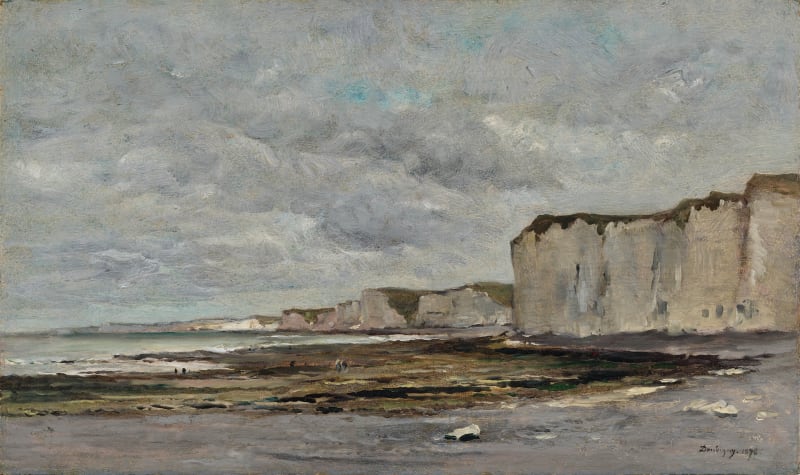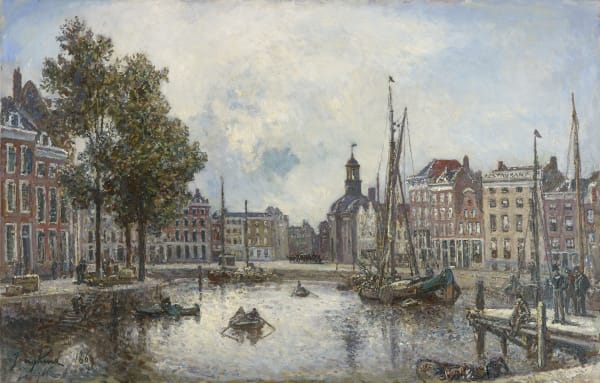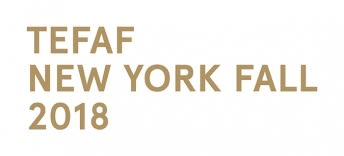Charles-François Daubigny French, 1817-1878
Charles-François Daubigny was a pioneer of plein-air painting who provided a link between the painters of the Barbizon School and the Impressionists. This was celebrated in 2016 with an exhibition at the Van Gogh Museum, entitled “Daubigny, Monet, Van Gogh: Impressions of Landscape”. Importantly, the artist was a great champion of the Impressionists during a period their artwork recieved little official recognition.
Born into a family of painters, Daubigny was taught by his father, Edmond François Daubigny, and by his uncle, the miniaturist Pierre Daubigny. Following in the footsteps of Jean-Baptiste Camille Corot, Daubigny began painting en plein-air, and had moved to Barbizon. In 1866 Daubigny visited England, eventually returning in 1780 to seek refuge from the Franco-Prussian. Here, he met Claude Monet and together they left for the Netherlands. Daubigny was to provide both inspiration and support to Monet and his fellow Impressionists. During their unpopularity in the 1860s, Daubigny vocally favoured Impressionist artwork on the Salon juries, where such paintings were usually disregarded. Later, Daubigny met Paul Cézanne, in Auvers-sur-Oise, a place from which Daubigny executed a number of his works.
Characterised by unique use of light effects and fluid brushstrokes, Daubigny’s paintings, convey feelings of spontaneity and truthfulness.
His work focuses on an emotional response to the landscape, breaking away from the traditional ‘salon’ paintings that depict historical scenes and portraits. Much of Daubigny’s time was spent on his studio boat – or Le Botin as he called it – another of his significant innovations which captured the transitional, temporal character of nature. We see these subsequent effects, in the paintings he made on board, whilst tracing the water’s pathways along the Seine, the Oise and frequently, around the region of Auvers. Daubigny’s innovations, such as this, paved the way for fresh experiments in landscape painting.
Particularly, the artist’s endeavours in colour and light heralded him one of the most significant landscape painters of the nineteenth century and encouraged Impressionist artists to reflect on new subject matters and techniques.
Daubigny’s original insight, in how to most aptly express nature, was acknowledged by Charles Baudelaire, who wrote that the artist’s landscapes “instantly convey to the viewer’s soul the original emotion with which they are imbued”.
The artist’s works can be seen in numerous museums worldwide, including the Louvre, Paris; The National Gallery, London; the Van Gogh Museum, Amsterdam; The Metropolitan Museum of Art, New York; the Museum of Fine Arts, Houston. The French government named him as an Officer of the Legion of Honor.
Charles-François Daubigny was a pioneer of plein-air painting who provided a link between the painters of the Barbizon School and the Impressionists. This was celebrated in 2016 with an exhibition at the Van Gogh Museum entitled “Daubigny, Monet, Van Gogh: Impressions of Landscape”. He was a great champion of impressionist artists at a time when they had little official recognition.
-
 Charles-François DaubignyLa mare au grand arbre , c.1865Red chalk on monogrammed paper34.5 x 54.5 cm
Charles-François DaubignyLa mare au grand arbre , c.1865Red chalk on monogrammed paper34.5 x 54.5 cm
13 9/16 x 21 7/16 inchesStamped lower right with sale after death (Lugt. L.518) -
 Charles-François DaubignyLa Plage de Berneval près de Dieppe, 1876Oil on panel29 x 49 cm
Charles-François DaubignyLa Plage de Berneval près de Dieppe, 1876Oil on panel29 x 49 cm
11 7/16 x 19 15/16 inchesSigned and dated lower right Daubigny 1876
-

Rhythm of lines and colours in French Avant-Garde
28 Jun - 26 Jul 2019Stoppenbach & Delestre is pleased to present 'Rhythm of lines and colours in French Avant-Garde', an exhibition including works by Charles-François Daubigny, Eugène Boudin, Armand Guillaumin, Hippolyte Petitjean, Louis Valtat,...Read more -

TEFAF Maastricht 2019
16 - 24 Mar 2019For TEFAF Maastricht 2019, Stoppenbach & Delestre is pleased to present a selection of 19th & 20th-century French artworks such as works by Louis Valtat, Henry Moret, Gustave Loiseau, Armand...Read more -

TEFAF New York Fall 2018 - Booth 321
25 - 31 Oct 2018Stoppenbach & Delestre is pleased to announce its participation in TEFAF New York Fall 2018. Featuring works by André Derain, Charles-François Daubigny, Maximilien Luce, Jean-Baptiste Camille Corot, Armand Guillaumin and...Read more





